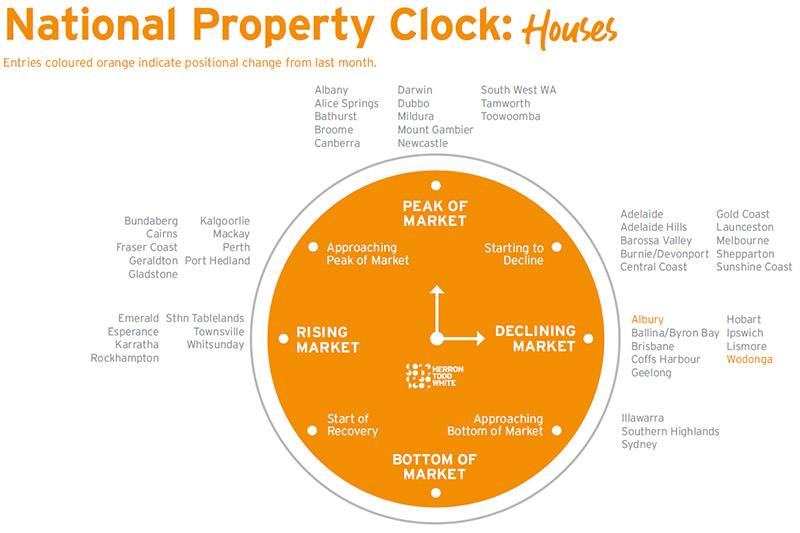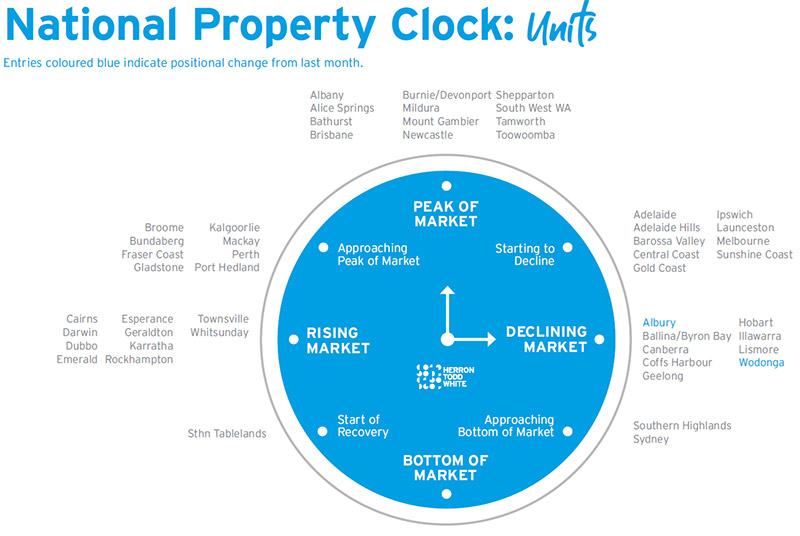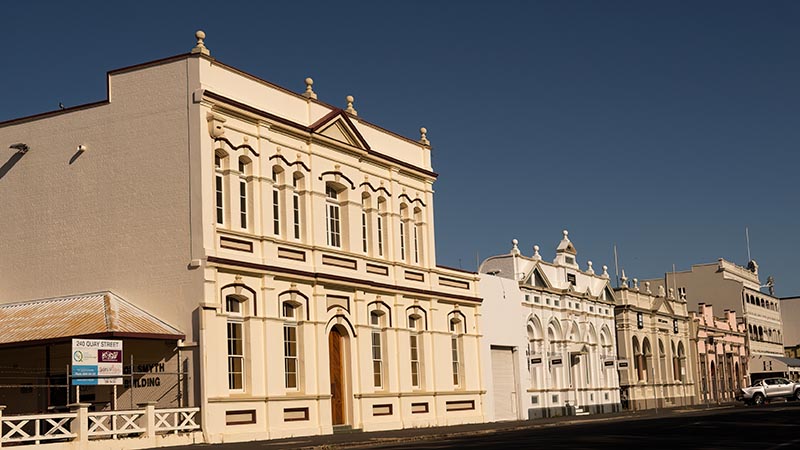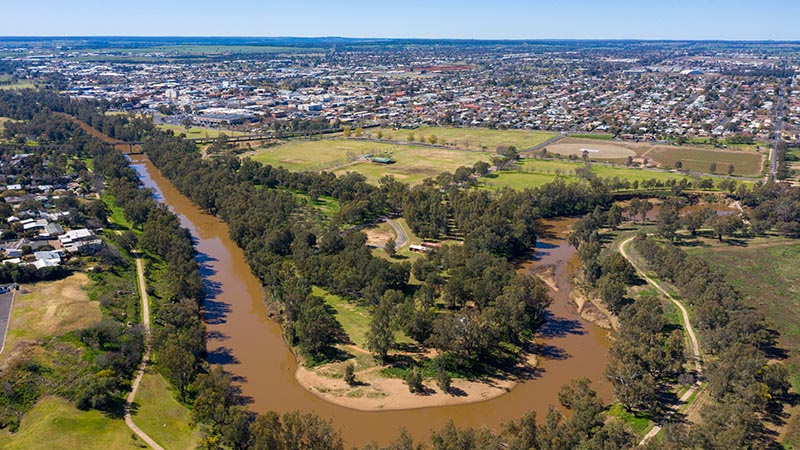Regional property markets dominate cities for capital growth potential
The property clock is ticking towards noon for many regional property markets listed as being in a capital growth phase but only one state capital was seen as being in a growth period.
Regional property markets across Australia are better placed to deliver capital growth than every capital city in Australia outside of Perth.
That’s the assessment made by independent property valuation and advisory group Herron Todd White, whose Month in Review for May designated 16 housing markets as being in a rising market – all but one of which (Perth) were regional centres.
Their analysis was just as compelling for units, with 17 of the 19 areas deemed to be in a rising market regional, with only Darwin and Perth among the capital cities expected to deliver real estate price growth.
While many prestige regional property markets that benefited most from the pandemic exodus from the cities have taken a hit, markets from Broome in Western Australia to Dubbo in New South Wales and Rockhampton in Queensland are experiencing an uplift that is expected to continue.
Migration driving regional property markets
The regional areas with the best property prospects are again enjoying an influx of migration.
Capital-to-regional migration has risen 7.9 per cent, its third highest level in the past five years, with most people moving to the regions coming from Sydney, which accounted for 90 per cent of all net capital outflows, according to the Regional Movers Index that is a partnership between Commonwealth Bank and the Regional Australia Institute.
Net outflows from Melbourne also rose significantly, from 44 per cent to 51 per cent, in the 12 months to March 2023. However, Perth and Brisbane proved popular for movers, recording net inflows of 26 and 24 per cent, respectively.
Across the board, regional Victoria and Queensland were the key destinations for capital city movers, accounting for 43 per cent and 29 per cent share of net outflows respectively, in the 12 months to March 2023.
Meanwhile the number of people moving to regional NSW fell, accounting for 23 per cent of net capital city outflows, down from 41 per cent in the prior period, according to the index released Wednesday (31 May).
The South East region in South Australia, which includes areas such as Kangaroo Island, the Fleurieu Peninsula and the Limestone Coast, remains the best performing regional house market on an annual basis, with value growth of 10.8 per cent in the 12 months to April 2023, according to CoreLogic.
The New England and North West (NSW) and Bunbury (WA) regions were the next best performers, up 4.9 per cent and 4.8 per cent respectively.
In contrast, NSW lifestyle markets, including the Richmond-Tweed (-24.2 per cent), the Southern Highlands and Shoalhaven (-16.0 per cent) and Illawarra (-13.7 per cent) regions recorded the largest annual declines in house values.

Tony Hutchinson, Managing Director of Hutchinson Real Estate in Broome, highlighted the fact that regional markets with diverse economies not reliant on a single industry, such as mining, were among those rated as being in a rising market.
“Broome had a long downturn and Covid brought many people looking for a sea change and a tourist boom also brought good energy to the town.
“Listings are now tight, turnover high and the rental market is very tight with steeply rising rental prices.”
Mr Hutchinson said there was more upside in the local property market.
“Melbourne buyers love Broome as it’s a great winter escape and we are certainly on the radar of Sydney investors too.
“As well pearling, cattle and tourism, including cruise ships, there’s a new mine opening between Broome and Derby that will generate a few hundred jobs, with a flow-on effect for the local economy.”
“My feeling is that the market will continue to creep up as interest rates peak and rental returns froth.”

A similar sense of buoyancy was evident on the other side of the country.
Laura Shooter, Managing Director of SJ Shooter Real Estate, said Dubbo is a consistently safe market for reliable capital growth, predictable rental yields and low vacancy rates.
“We know that our pipeline of state significant infrastructure projects in our region means demand for homes in our area is only going to get stronger,” Ms Shooter said.
“The leading employment industry is health care and social assistance, followed by construction, retail trade and training and education, providing a stable economic mix for our population.”
A shortage of units compared to other regional areas meant this market had a stronger outlook than houses, which were likely at or near a peak.
“Units have been undersupplied over a long period of time, and this is having a compounding effect as an increasing number of residents are seeking this type of lower-maintenance accommodation.”
Sydneysiders remained the biggest source of non-local buyers.
“The interest rate hikes have had an interesting effect, in that demand is still strong, though many people’s borrowing capacity has been reduced, so buyers are still eager to buy but are potentially shopping in a different price bracket.”
In Queensland, a string of towns were rated as being in a rising market for units and houses, including Rockhampton, Bundaberg, Cairns, Mackay, Fraser Coast, Townsville and Whitsundays.
Cara Pincombe, Associate Director, Herron Todd White, said Rockhampton offered great investment opportunities, whether on a beer or champagne budget.
“Rockyview on the northern outskirts of Rockhampton is the prime area, or Inverness on the Capricorn Coast provides a similar lifestyle with closer proximity to the coast.
“If modern homes without the commute are more your style, the leafy suburb of Frenchville in north Rockhampton is the cream of the crop,” Ms Pincombe said.
“If, however, you find yourself working to a beer budget, there are some options that can still get you into these prime localities if you are prepared to compromise.
“One option would be looking to adjoining suburbs with similar characteristics, such as the elevated areas of Wandal, which provide similar style homes, elevation and proximity to major services as The Range.
“Alternatively, sacrificing elevation or room accommodation can see you enter The Range market in say a two-bedroom plus sleepout Queenslander at the bottom of or on the western slopes of The Range, although the compromise to a two-bedroom dwelling may be considered too great for the long term owner-occupier.
“Given the age of Rockhampton, purchasing vacant land is not an option for entry-level into the area, so a dated two-bedroom unit for around $200,000 would represent the absolute entry level to The Range with limited detached housing available under $280,000.”
Long term property price growth
Like the rest of Australia, regional Australia is experiencing large declines in dwelling approvals and that limited generation of new housing supply is propping up prices in the face of interest rate hikes.
Regional Australia recorded 3,090 total dwelling approvals in April 2023. This represents a 23 per cent decline on the same period last year compared to combined metro, which is down 30 per cent.
Maree Kilroy, Senior Economist for Oxford Economics Australia, said it has been a horrible start for dwelling approvals in 2023, including in the regions.
“On the house front, regional New South Wales saw its weakest monthly result since late 2019 and regional Victoria since January 2017 in April,” Ms Kilroy told API Magazine.
The total number of dwellings approved in Australia fell 8.1 per cent in April, according to Australian Bureau of Statistics data released Tuesday (30 May).
The past five years has, however, seen some regional homeowners win the ‘property lottery’ with gains as much as $1.1 million in median home prices, according to PropTrack data released Wednesday (31 May).
The suburbs that saw the biggest increases in median house prices in the past five years include:
- Bright (Vic) – 152 per cent increase in median house price to $1,285,000
- Jindabyne (NSW) – 148 per cent increase in house price to a median of $1,550,000
- Venus Bay (Vic) – 133 per cent increase in median house price to $687,000.
It’s not just houses that have seen phenomenal growth. Units in some areas have seen gains of as much as $700,000 in the past five years, including:
- Noosaville (QLD) – 108 per cent increase in median unit price to $935,000
- Jindabyne (NSW) – 105 per cent increase in median unit price to $718,000
- Sunshine Beach (QLD) – 102 per cent increase in median unit price to $1,425,000
The mantra that property should be seen as a long-term investment is also underscored by the growth experienced in the best performing regional property markets over the past ten years.
Tremendous capital growth since 2013 has seen multi-million dollar profits in some regions. Median house price growth in the coveted Byron Bay topped the list, jumping a staggering 362 per cent or $2.35 million over 10 years, according to PropTrack.
Lifestyle areas saw the biggest growth in house prices, as property seekers sought out coastal and parkside living.
Other top suburbs include Bright in Victoria (257 per cent increase in median house price, up $930,000 since 2013), Suffolk Park (NSW, 256 per cent increase, up $1.51 million), and Berry (NSW, 256 per cent increase, up $1.51 million).























